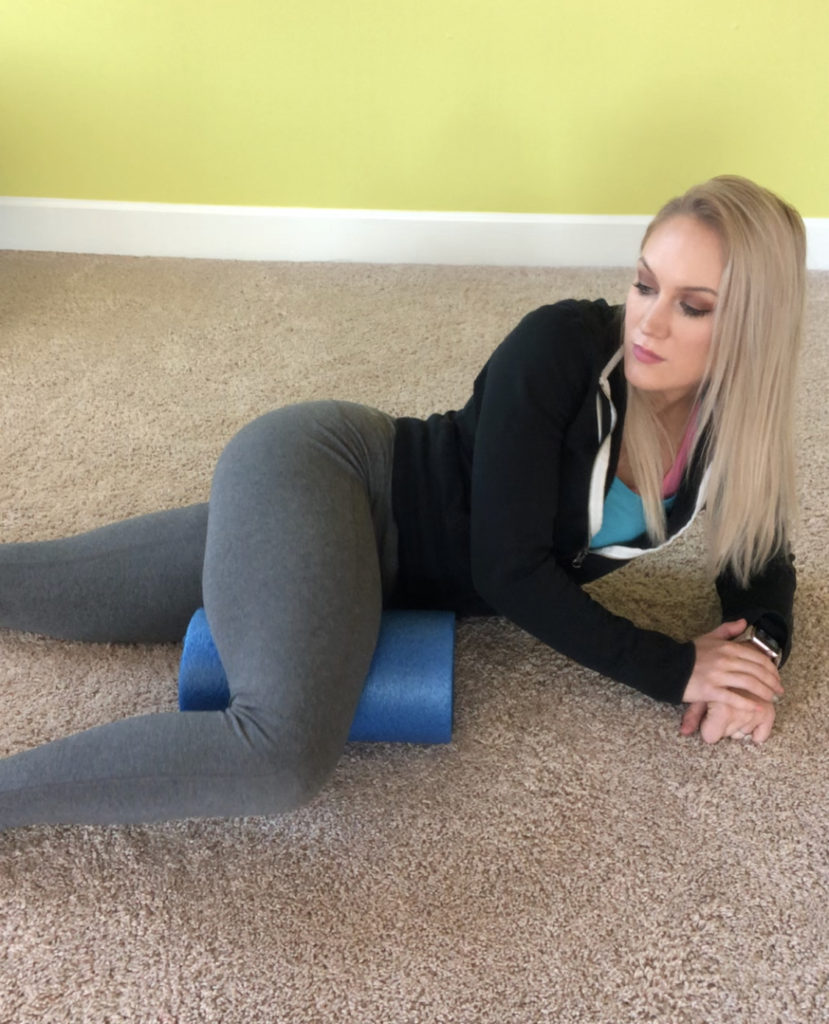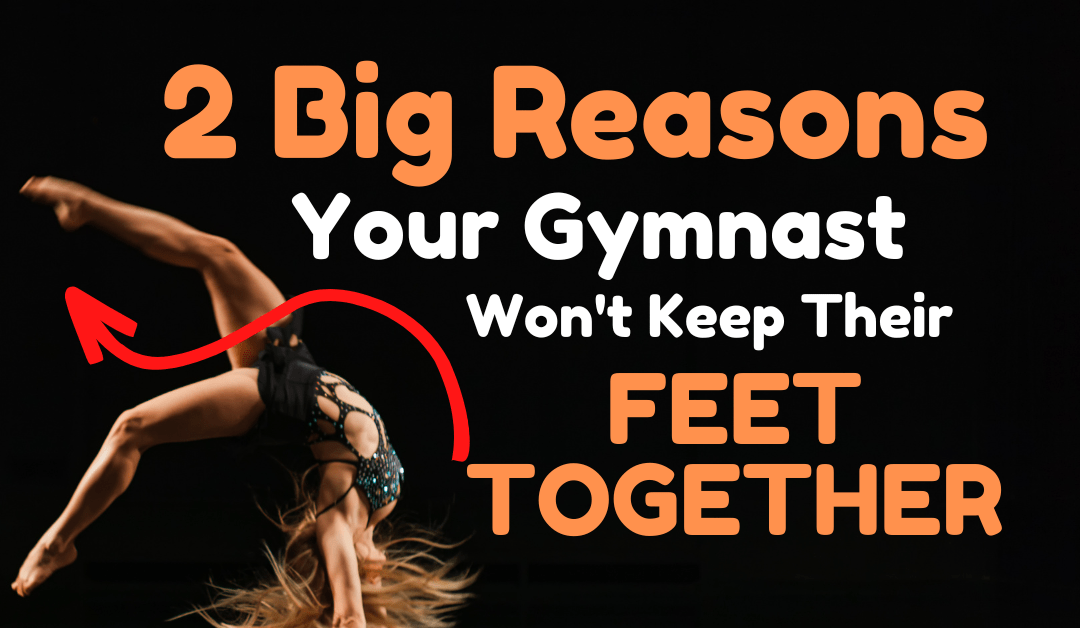Your gymnast’s feet won’t stay together for the life of them, and as a coach or parent, you’re over it!
Does it seem like no matter how many times you remind them, they just won’t squeeze their ankles to touch? It’s so simple, right?! Plus, keeping the feet together is a staple critique for good gymnastics execution.
But maybe the issue is they can’t keep their feet together.
Yup, CAN’T. And if you know me at all, that’s a word I don’t use lightly. Because maybe it isn’t an issue of the gymnast being lazy, sloppy, or not strong enough to keep their feet together. In fact, it’s more likely a movement pattern issue.
Let’s talk about what’s NOT the issue.
Let me give you a couple real-life examples of why gymnasts get stuck in “feet-apart” land.
And I’ll tell you, it has a lot to do with what the coach interprets the problem is.
It’s usually not for a lack of effort.
I recently spoke with a coach who told me how frustrated he was that one of his gymnasts kept tumbling with their feet apart. He figured the gymnast was being intentionally contrary or simply didn’t understand what he was telling them to do.
In reality, their body just won’t seem to cooperate. Even with the best intentions, this interpretation of effort can be super harmful to a gymnast.
Especially one who is already trying their best.
It’s also rarely a body quirk.
During one of my consultations at a new gym, I gave the small correction to a girl to keep her feet together.
Immediately, her coach informed me this girl had a funny quirk where her feet don’t go together. How silly, right?!
The girl tried to stand with her feet touching to demonstrate, but no dice. She grinned up at me, feet obstinately 3 inches apart, as if she was showing me a party trick.
I looked over at her coach who rolled her eyes and shrugged. “Some people are just built like that!” she said.
Now, the harm from this statement is not intentional, but it doesn’t negate the effect. If she was born that way, why should she bother trying?
There’s a common misbelief that many fixable problems are unfixable quirks. But good news! There are 3 very fixable reasons your gymnast can’t keep her feet together.
1.) Tight hips make it hard to keep their feet together.
Your hips may not be anywhere close to those stubborn ankles, but your body works like a chain.
Just like bent arms on a kip affect the force a gymnast can generate into a cast, one little impairment affects the end result.
Check out the knees.
“Hips? Knees? I thought we were talking ankles here.”
Yup, stay with me.
If the gymnast’s knees collapse in during a squat, this can point to overactive muscles at the hips.
“Okay, but what about the ankles?”
Well, think about it! It’s going to be very difficult to get your ankles to touch if your knees are already bumping into one another. There’s no more room to squeeze!
Release the tight muscles.
The muscles that are pulling those hips (and knees) together are called the adductors.
These are the muscles that sit on the inside of your thighs. Their job is to pull your legs together. Sounds ideal for gymnastics, right?! But sometimes these muscles can be overachievers.
If these muscles are too active, they’ll start to cause movement impairments, pulling the knees in too far, or not allowing them space to push out on critical movements like squats or landings.

In order to release this tension, we need to roll them out. Swing your leg over a foam roller and roll out the inner thigh, hip to knee. Hold each sore spot for 30 seconds.
This is best done before practice, after practice, and even on days away from the gym. Consistency is key!
Don’t make it worse.
The other thing we want to avoid (at least temporarily) is tightening the adductors further. Avoid exercises that focus too much on pulling the legs together.
That doesn’t mean do all your tumbling in a straddle, of course. My point is, they’re probably already working these muscles enough during everyday skills.
Besides, we have other muscles we’re going to need to focus on activating.
2.) Underactive glutes make it tough to keep their feet together.
Where the hips are overactive, the glutes might not be pulling their weight.
[Sometimes people refer to this discrepancy as “strong” adductors and “weak” glutes. I prefer “overactive” and “underactive.” After all, there’s not a muscle on a gymnast that’s weak. The issue is less about the force the muscle can generate, and more about the balance of how much work it’s taking on compared to other muscles.]
Activate the glutes.
Many times, gymnasts bank on their quads, adductors, and core to stabilize themselves, forgetting to engage their glutes at all.
Not only are they missing out on the power these large muscles can generate, the glutes play a huge role in keeping their knees in line with their toes.
TRY IT:
Stand up and squeeze your glutes. Your hips should slightly rotate out, and your knees will follow. This external rotation negates the caving-in that happens with tight hips. This then leaves room for the ankles to come together!
Every gymnast can squeeze their glutes, but the trick is to make it as natural as squeezing their cores. So in comes activation!
We all know drills help gymnasts feel the correct movement to translate it to a skill. They’re rarely about strength and more about body awareness.
Think of the following exercises the same way. They’re best done at the beginning of practice or before events. We’re showing the gymnast how to isolate and activate the glutes so that they know what these muscles should be doing during a tumbling pass.
Here are some of my favorite glute activation exercises:
- Quadruped stag lifts – in a crawling position, lift one bent knee behind you and up toward the ceiling, keeping the core engaged. Repeat on the other side.
- Fire hydrants – in a crawling position, lift one bent leg out to the side, bringing the knee to hip level. Repeat on the other side.
- Quadruped leg swings – in a crawling position, lift one straight leg behind you and swing it out to the side, keeping the foot level with the hips. Repeat on the other side.
- Clamshells – lying on your side in an elbow support, bend the knees in. Keep the feet together and open the knees, squeezing the glutes each time. Repeat on the other side.
- Glute bridges – lying on your back with your feet on the floor and knees bent, ensure your knees are in line with or open wider than your middle toes. Lift your hips up and squeeze your core and glutes at the top, forming a straight line from knee to shoulder.
All of these activation exercises can be supplemented with a small loop band around the top of the knees OR done without. Try to aim for 12–15 reps per side.
Bonus! Tip #3.) Low hip strength won’t help keep their feet together.
Okay, don’t yell at me. I’m going to tell you to do something I told you to avoid in the first part.
And that’s strengthening the adductors.
Fair warning!
Now, the reason I list this last is because this should ONLY be done after determining that tight hips or underactive glutes are NOT the problem.
I can’t stress this enough. If there IS a fundamental movement issue, strengthening the adductors will only worsen the problem.
If the issue is not a fundamental movement pattern issue, only THEN can we talk about lack of strength in the muscles that hold the legs together.
Even then, the glutes should still be activated regularly to maintain balance between the glutes and adductors.
Strengthen the hips.
Here are a few exercises to strengthen the adductors:
- Side plank – low or high plank with feet stacked
- Side plank with top leg elevation – hold a side plank but elevate top foot on a beam or bench and allow the bottom foot to hover underneath.
- Wall sit with ball squeeze – Do a wall sit with a med ball placed between the knees. Maintain constant pressure on the ball, but keep the knees in line with the middle toes.
- V-ups with ball transfer – perform V-ups while transferring a stability ball or med ball between the arms and legs on each rep.
- Slider side lunges – Place one foot on a slider. Allow the slider leg to slide laterally (keeping the knee straight) as the other leg sinks into a squat. When rising, squeeze to bring the slider foot back to the starting position.
Won’t keep their feet together? Or can’t?
To sum it all up, sometimes it’s our responsibility as coaches to switch up our perspective. If we can start to understand the biological issues that stand in the way of our gymnasts’ progress, we can start to coach more effectively.
Maybe it’s an issue of tight hips, poorly tracking knees, or lack of strength. Or maybe we’re right, and it is an issue of just plain laziness. (I won’t pretend that doesn’t happen.)
However, I do think we all have the responsibility to cross off all other possibilities before we hit the blame-game level.
If you have any questions during the assessment of your gymnasts or how to implement these exercises, leave a comment below or send me an email! I will do my best to reply quickly.

